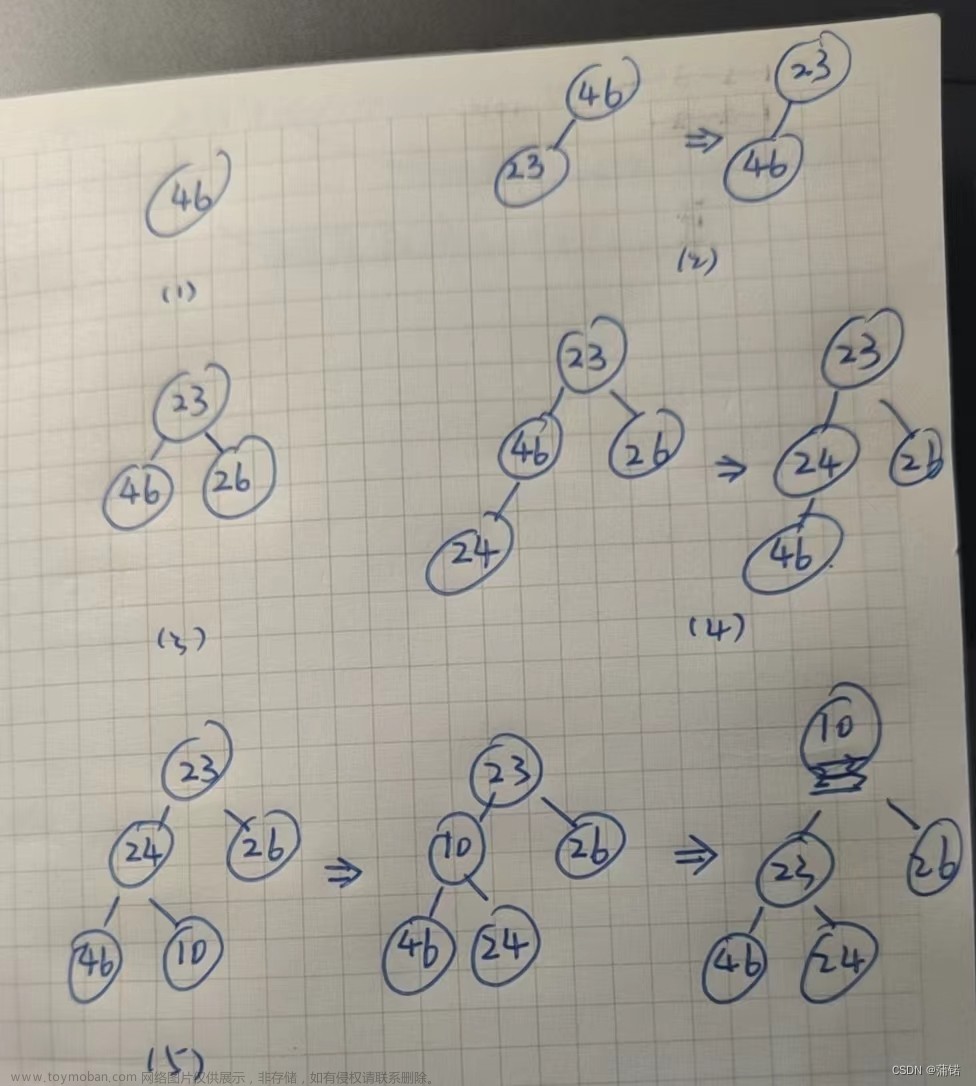排序和建堆的使用方式(自定义为例)
在C++中,排序和建堆的比较规则是通过比较函数或者比较对象来定义的。这通常涉及到使用函数对象(Functor)或者函数指针,以决定元素之间的大小关系。
举例: 利用函数排序
#include <iostream>
#include <vector>
#include <algorithm>
// 自定义比较函数
bool myComparator(int a, int b) {
return a > b; // 降序排序
}
int main() {
std::vector<int> vec = {5, 2, 8, 1, 6};
// 使用自定义比较函数进行降序排序
std::sort(vec.begin(), vec.end(), myComparator);
// 输出排序后的结果
for (int num : vec) {
std::cout << num << " ";
}
return 0;
}
举例: 利用对象排序,注意sort第三个实参中有括号,是建立临时对象
#include <iostream>
#include <vector>
#include <algorithm>
// 自定义比较对象
struct MyComparator {
bool operator()(int a, int b) {
return a > b; // 降序排序
}
};
int main() {
std::vector<int> vec = {5, 2, 8, 1, 6};
// 使用自定义比较对象进行降序排序
std::sort(vec.begin(), vec.end(), MyComparator());
// 输出排序后的结果
for (int num : vec) {
std::cout << num << " ";
}
return 0;
}
举例: 利用对象建堆,注意优先级队列(本例中为小顶堆)第三个模板参数不带括号
#include <iostream>
#include <queue>
// 自定义比较对象
struct MyComparator {
bool operator()(int a, int b) {
return a > b; // 小顶堆,小的元素排在前面
}
};
int main() {
std::priority_queue<int, std::vector<int>, MyComparator> minHeap;
// 插入元素
minHeap.push(5);
minHeap.push(2);
minHeap.push(8);
minHeap.push(1);
minHeap.push(6);
// 弹出并输出元素
while (!minHeap.empty()) {
std::cout << minHeap.top() << " ";
minHeap.pop();
}
return 0;
}
结论
如果是排序,less<T>是升序,(从左到右遍历下标,数组元素从小到大);greater<T>是降序(从左到右遍历下标,元素从大到小)。
如果是建堆,less<T>是大顶堆,greater<T>是小顶堆。
less()、greater()原理
假设比较规则就是comp(a, b),对于排序来说,左边元素就是前一个a,右边元素就是后一个b;对于建堆,新插入一个元素时,插入到最后一个叶子,这时要整理堆内元素满足大/小顶堆,a代表新插入的结点,b代表它的父节点。
我们写自定义比较规则就可以依照这个规则。
而标准库中的less<T>就是让a比b小,对应排序就是左边比右边小,就是升序;对于建堆就是让新插入节点比它的父结点小,就是大顶堆。
greater<T>相反。
默认都是用less<T>。
自定义规则
这部分参考里的例子写的很好,直接贴过来了。
符合两个条件:
bool:返回值bool
return x<y;:重载<之类的操作符,并且要决定比较什么元素。
PS:建议还要常引用,保险,禁止发生修改要比较的元素可能。
举例:数组
函数:使用时不加括号,加了报错
类的对象:注意,排序时的类必须使用类的对象才对,直接使用类报错。
#include <iostream>
#include <algorithm>
#include <vector>
using namespace std;
// 重写排序函数
bool cmpfunc(const int &a, const int &b)
{
return a < b;
// < 升序; > 降序
}
// 模仿less、greater构建类
struct cmpClass
{
bool operator()(const int &i, const int &j)
{
return (i < j);
}
}cmpClassObject; // 注意,排序时的类必须使用类的对象才对,使用类报错。
int main()
{
// 使用函数
vector<int> v1 = {2, 3, 1, 6, 2, 5, 4};
// 使用时不加括号,加了报错
sort(v1.begin(), v1.end(), cmpfunc);
for (int i = 0; i < v1.size(); i++)
{
cout << v1[i] << " ";
}
cout << endl;
// 1 2 2 3 4 5 6
// 使用类的对象
vector<int> v2 = {2, 3, 1, 6, 2, 5, 4};
sort(v2.begin(), v2.end(), cmpClassObject);
for (int i = 0; i < v2.size(); i++)
{
cout << v2[i] << " ";
}
cout << endl;
// 1 2 2 3 4 5 6
return 0;
}
举例:优先级队列
定义类时同时定义操作符重载函数:操作符重载函数,必须是具体的操作符<之类的,写()报错
自定义类,自定义比较函数:操作符重载函数,必须是具体的操作符<之类的,写()报错
自定义类,自定义包含比较函数的结构体:操作符重载函数,必须是写()文章来源:https://www.toymoban.com/news/detail-809680.html
#include <iostream>
#include <queue>
using namespace std;
/******** 定义类时同时定义操作符重载函数 ********/
struct Node1
{
// 要比较的元素
int x;
// 构造函数
Node1(int x) { this->x = x; }
// 操作符重载函数,必须是具体的操作符<之类的,写()报错
bool operator<(const Node1 &b) const
{
// 实现less中需要的<,大顶堆
return x < b.x;
}
};
/******** 自定义类,自定义比较函数 ********/
struct Node2
{
// 要比较的元素
int x;
// 构造函数
Node2(int x) { this->x = x; }
};
// 操作符重载函数,必须是具体的操作符<之类的,写()报错
bool operator<(const Node2 &a, const Node2 &b)
{
// less,大顶堆
return a.x < b.x;
}
/******** 自定义类,自定义包含比较函数的结构体 ********/
struct Node3
{
// 要比较的元素
int x;
// 构造函数
Node3(int x) { this->x = x; }
};
struct cmpClass
{
// 操作符重载函数,必须是写()
bool operator()(const Node3 &a, const Node3 &b)
{
// less,大顶堆
return a.x < b.x;
}
};
int main()
{
/******** 初始化优先级队列的对象p ********/
// Node1类型,默认使用vector,小顶堆,同 priority_queue<Node1, vector<Node1>, less<Node1> > p;
priority_queue<Node1> p;
// 乱序入队
p.emplace(1);
p.emplace(3);
p.emplace(2);
// 弹出队首
while (!p.empty())
{
cout << p.top().x << " ";
p.pop();
}
cout << endl;
// 3 2 1
/******** 初始化优先级队列的对象q ********/
// 同 priority_queue<Node2> q;
priority_queue<Node2, vector<Node2>, less<Node2>> q;
// 乱序入队
q.emplace(1);
q.emplace(3);
q.emplace(2);
// 弹出队首
while (!q.empty())
{
cout << q.top().x << " ";
q.pop();
}
cout << endl;
// 3 2 1
/******** 初始化优先级队列的对象r ********/
priority_queue<Node3, vector<Node3>, cmpClass> r;
// 乱序入队
r.emplace(1);
r.emplace(3);
r.emplace(2);
// 弹出队首
while (!r.empty())
{
cout << r.top().x << " ";
r.pop();
}
cout << endl;
// 3 2 1
return 0;
}
参考:
C++:std::greater()、std::less()、自定义比较函数的规则
C++ std::优先级队列priority_queue文章来源地址https://www.toymoban.com/news/detail-809680.html
到了这里,关于关于C++中排序和建堆的比较规则:std::greater()、std::less()、自定义比较规则的文章就介绍完了。如果您还想了解更多内容,请在右上角搜索TOY模板网以前的文章或继续浏览下面的相关文章,希望大家以后多多支持TOY模板网!










